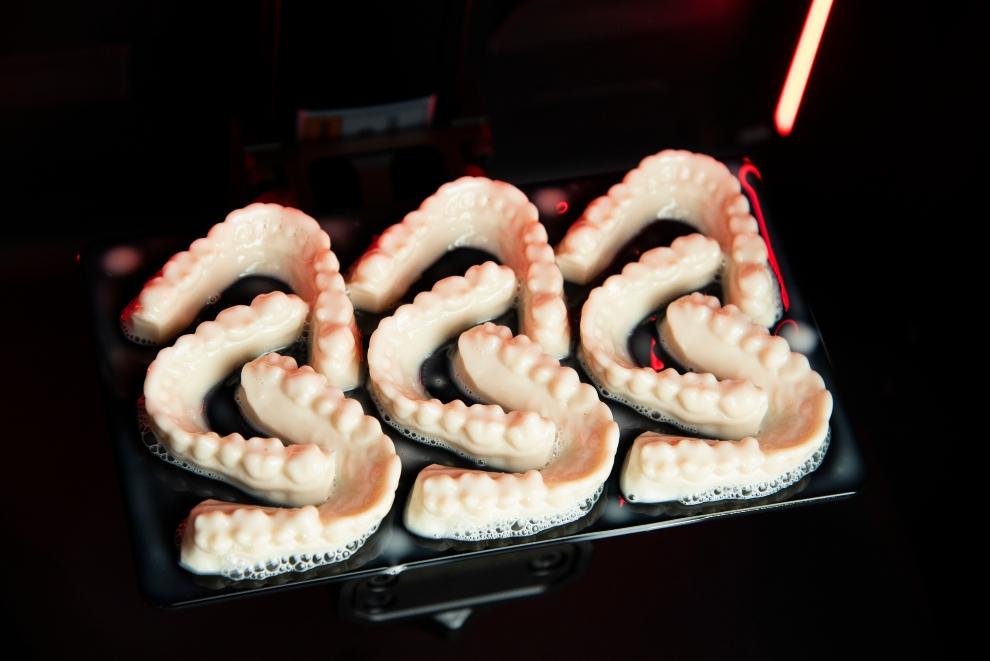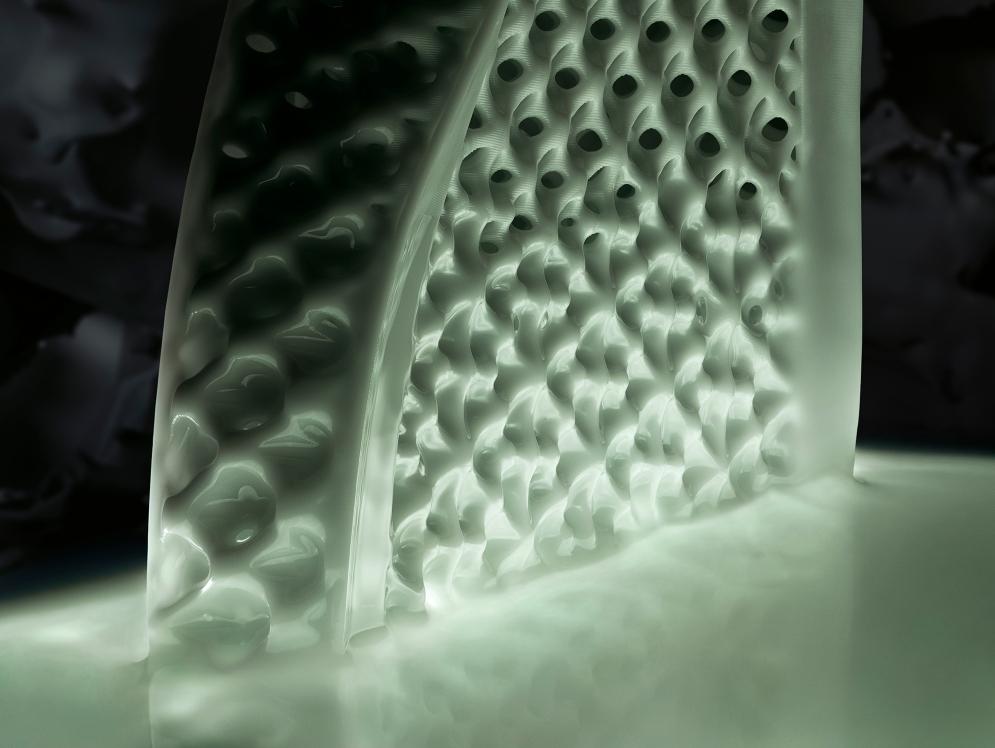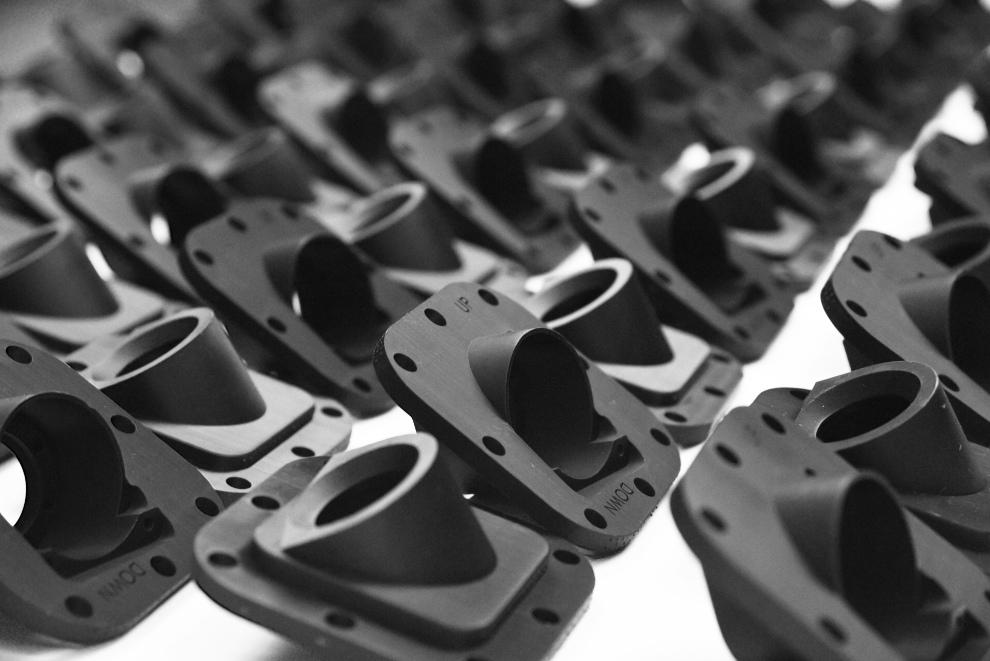- FMA
- The Fabricator
- FABTECH
- Canadian Metalworking
Our Publications
Categories
- Additive Manufacturing
- Aluminum Welding
- Arc Welding
- Assembly and Joining
- Automation and Robotics
- Bending and Forming
- Consumables
- Cutting and Weld Prep
- Electric Vehicles
- En Español
- Finishing
- Hydroforming
- Laser Cutting
- Laser Welding
- Machining
- Manufacturing Software
- Materials Handling
- Metals/Materials
- Oxyfuel Cutting
- Plasma Cutting
- Power Tools
- Punching and Other Holemaking
- Roll Forming
- Safety
- Sawing
- Shearing
- Shop Management
- Testing and Measuring
- Tube and Pipe Fabrication
- Tube and Pipe Production
- Waterjet Cutting
Industry Directory
Webcasts
Podcasts
FAB 40
Advertise
Subscribe
Account Login
Search
DLP 3D printing advantages, pros and cons
Digital light processing results in faster build speeds while eliminating the need for lasers
- By Kip Hanson
- Updated January 24, 2023
- February 26, 2021
- Article
- Additive Manufacturing

Dental products like these arches are an important market for Origin and other DLP-based printer manufacturers. Origin
Stereolithography (SLA) ranks among the oldest and most mature of all 3D printing technologies. Its capabilities are well-understood; resin selection is broad; and it can be used to 3D-print accurate and, often, functional prototypes and end-use products.
As with many additive manufacturing processes, however, SLA build speed is limited. Because each layer must be traced with a beam of ultraviolet laser light just a few hair-widths in diameter, printing with SLA is akin to sculpting a Mona Lisa with a 3D Etch-a-Sketch.
There are alternatives, of course. One of them is digital light processing (DLP). Different styles of DLP systems are available, but all share a common thread: Rather than the one-line-at-a-time approach, DLP printers project a series of images onto resin, curing each layer sequentially and nearly instantaneously. This approach results in faster build speeds while eliminating the need for expensive lasers and galvanometers.
DLP, like SLA, builds parts from a photoreactive resin and features a movable build plate. DLP’s UV light source, however, is a high-resolution digital projector rather than a laser beam. The projector flashes individual images of a digitally sliced CAD model upwards onto a transparent plate at the bottom of the resin tank, thus cross-linking the molecules immediately on the opposite side. As the digital “movie” plays on, the build plate moves upwards, pulling the workpiece with it and exposing fresh resin.
When complete, the green workpieces are cleaned and then cured in an oven or UV light chamber, depending on the brand of 3D printer.
Enter the Dead Zone
As one might expect, each DLP printer manufacturer has a unique take on the technology. Often, what distinguishes one system from another is the polymerization process.
Carbon Inc., Redwood City, Calif., uses its Continuous Liquid Interface Production technology, along with a range of proprietary resins, to deliver Digital Light Synthesis (DLS). According to the company, the 3D printing process can print parts 100 times faster than SLA.
Carbon’s senior technical product marketing manager, Rob L’Heureux, explained that DLS shares many similarities with competing digital light printing systems but is a completely different process. “Both use resins, both have a light source and build platform, and both look very similar in operation,” he said. “What separates Carbon is the use of an oxygen-filled inhibition barrier that we refer to as a ‘dead zone’ and our dual-cure materials. Dual-cure materials offer improved part quality, and the dead zone significantly increases build speeds.”
Anyone who’s seen reports on Carbon’s website about 3D-printing running shoe midsoles will recognize the potential of DLS and similar technologies. Where many AM processes remain limited to prototype and low-volume production, so-called “continuous printing systems” offer the promise of high-volume production of end-use products.
L’Heureux points to Minneapolis-based Resolution Medical’s use of Carbon M2 printers to produce nasopharyngeal swabs for the COVID-19 pandemic, as well as a broad range of other medical devices.

Carbon and adidas collaborated on FutureCraft 4D, the first performance shoe with a 3D-printed midsole. Carbon
“We’re especially suitable for parts roughly two fingers wide and smaller,” he said. “This allows manufacturers to really pack the build platform and maximize throughput.
“Ford Motor Co. has begun using our systems to produce parking brake brackets for its GT500 Mustang and HVAC service parts for the Focus,” L’Heureux continued. “And NASA has certified Carbon-produced parts for the gas nozzles in its Seeker autonomous robot, designed to inspect the International Space Station and other orbiting spacecraft.”
Controlling Forces During DLP 3D Printing
Carbon isn’t the only company with DLP success stories to share. The five-year-old San Francisco company Origin has been busy using printers based on its patented Programmable Photopolymerization technology to print nasal swabs. Stratasys, which acquired Origin in early 2021, has been marketing the swabs.
Origin also took first place in the U.S. Air Force’s Advanced Manufacturing Olympics. Working with software company nTopology and material provider Henkel, Origin designed and printed a multimaterial hydraulic tube clamp for F-16 aircraft. The Origin team bested eight other participants and won the contest’s $100,000 prize.
Fin Watterson, Origin’s director of product marketing for production photopolymers, noted that the company’s printer doesn’t feature an oxygen-fed dead zone. Instead, it relies on a pneumatic pumping mechanism to inflate a sensor-filled, clear Teflon membrane situated between the print platform and window.
As with Carbon DLS, the membrane serves both to inhibit and control the photopolymerization process and prevent the part from sticking to the window. As each layer is completed, the membrane deflates, the build platform cycles upwards, and the process repeats.
“Long story short, it allows us to reach the same or greater speeds as competing oxygen-aided 3D printers by using a straightforward and reliable mechanical process to control the polymerization rate,” he said. “And because this approach reduces the peel forces required to lift the part away from the build zone, it presents the possibility of printing molds and other large, blocky objects that are difficult to do on most DLP-based systems. Also, we’re able to use nitrogen and other gases to make the environment inert, opening the door to completely novel chemistries that cannot be printed in the presence of oxygen.”
Acceleration Station
Diversified Plastics Inc. (DPI), an employee-owned plastic injection molding company in Brooklyn Park, Minn., doesn’t print molds on its Carbon M2 printers. It does, however, use the M2s to produce parts by the thousands.
The company’s engineering manager, Vincent Pope, said DPI got into 3D printing three years ago as part of its Acceleration Station service, the aim of which is to deliver prototype and production parts to customers “in days not weeks” and without the need for tooling.
“When attempting to meet customer needs for quick-turn or prototype plastic parts, conventional plastic injection molding can be cost-prohibitive and time-consuming,” Pope said. “That’s because every part iteration requires a mold modification—or maybe an entirely new mold if the change is drastic.”

Origin 3D-printed and postprocessed 100 camera housings in less than 24 hours, reportedly cutting the price per part by 99% compared to CNC machining. Origin
With AM, part design changes are simple, fast, and cost-effective, he said. A customer sends DPI a new file and the parts are built in hours.
Pope added that 3D printing allows the production of complex geometries that can’t be injection-molded. “Our customers should not limit their creativity due to conventional manufacturing methodologies,” he said, adding that AM offers opportunities to design “better products [while] reducing costs and compressing time to market.”
AM Use In DLP 3D Printing
Enhancing these capabilities is the growing number of materials being brought to the manufacturing table. They include soft, flexible materials that mimic thermoplastic polyurethane; biocompatible materials comparable to medical-grade ABS; heat- and flame-resistant, nylon-like materials; and optically clear materials similar to polycarbonate.
Pope added that 3D-printed medical devices, like their injection-molded counterparts, must be sterilizable, and DPI must be customer-certified to produce them.
“Medical is around 60% of what we do here. And even though the number of polymers available to us for 3D printing doesn’t compare to the number for injection molding, we haven’t hit too many roadblocks on meeting our customers’ needs,” he said.
“The aesthetics and finish of [3D-printed parts] are quite close to injection-molded parts, and the functional properties are just as good in most cases. When you add in 3D printing’s greater design freedom, it’s clear that it will play an increasingly important role for us going forward,” Pope said.
About the Author

Kip Hanson
About the Publication
- Podcasting
- Podcast:
- The Fabricator Podcast
- Published:
- 04/16/2024
- Running Time:
- 63:29
In this episode of The Fabricator Podcast, Caleb Chamberlain, co-founder and CEO of OSH Cut, discusses his company’s...
- Trending Articles
- Industry Events
16th Annual Safety Conference
- April 30 - May 1, 2024
- Elgin,
Pipe and Tube Conference
- May 21 - 22, 2024
- Omaha, NE
World-Class Roll Forming Workshop
- June 5 - 6, 2024
- Louisville, KY
Advanced Laser Application Workshop
- June 25 - 27, 2024
- Novi, MI



























